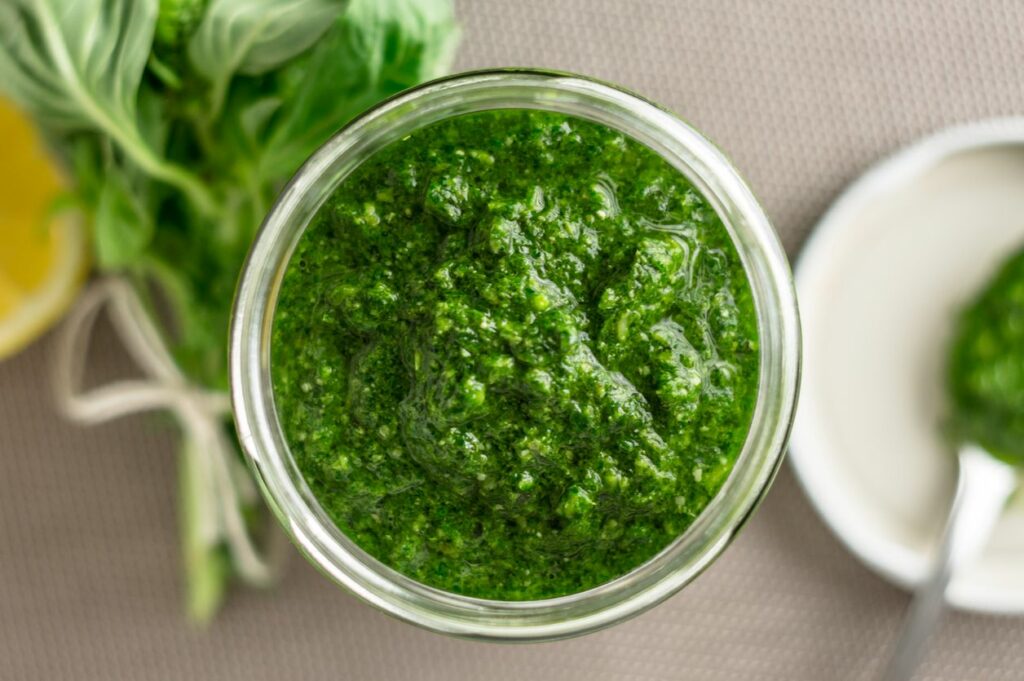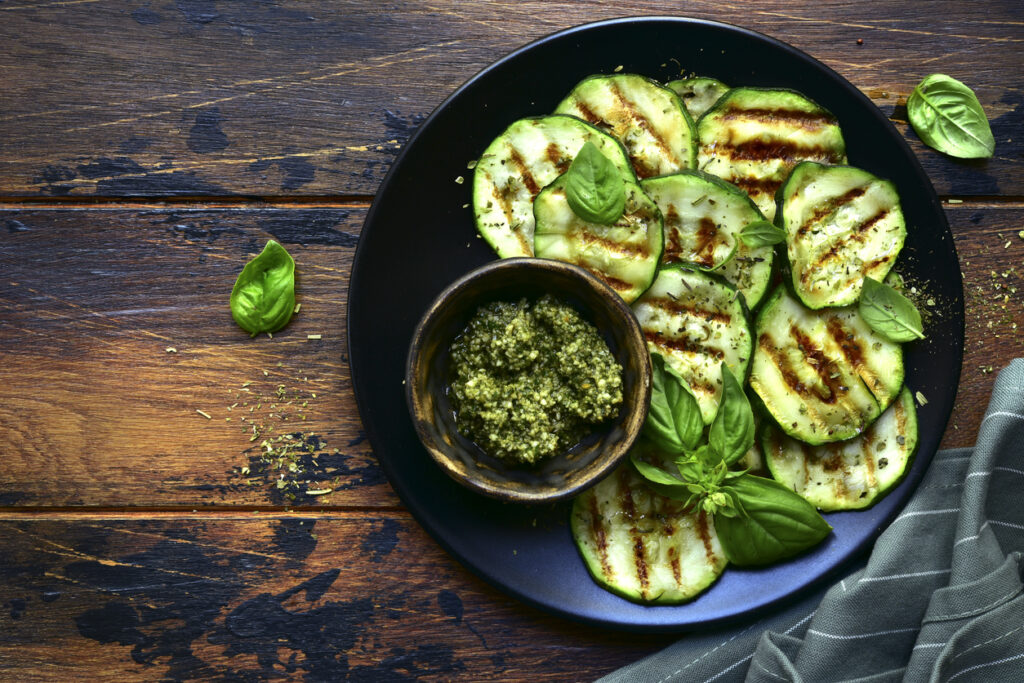Are you tired of settling for a mediocre glass of wine when enjoying your favorite Italian delicacy? Don’t worry; we’ve got just the solution for you! Pesto pasta is a culinary masterpiece in itself—its complex flavors and vibrant colors are enough to make anyone weak at the knees.
But why stop at just savoring this delightful dish when you can enhance its magic by finding the perfect wine pairing? From crisp whites to bold reds, get ready for an unforgettable gastronomic experience as we unveil some hidden gems guaranteed to take your love affair with pesto pasta to new heights.

Exploring the Perfect Wine Pairing for Pesto Pasta
When it comes to pairing wine with pesto pasta, certain factors need to be taken into consideration. Pesto sauce is made from fresh basil leaves, garlic, pine nuts, Parmesan cheese and olive oil. It offers a unique blend of flavors that can both compliment and challenge the palate. To truly enhance the dining experience, a wine pairing should have enough acidity and body to stand up to the bold flavors of the pesto sauce without overpowering them.

One classic option for a perfect wine pairing with pesto pasta is Sauvignon Blanc. This crisp white wine has high acidity and herbal notes that beautifully complement the basil in the pesto sauce. The natural citrusy undertones in Sauvignon Blanc also provide a refreshing contrast to the richness of the pasta dish. Its vibrant character helps cleanse the palate between bites, ensuring each mouthful remains delightful.

For those seeking a more adventurous match, a lighter-bodied red such as Barbera could be an excellent choice. This Italian varietal boasts bright cherry flavors that harmonize well with the earthiness of pine nuts present in pesto sauce. The low tannin levels prevent any bitterness from overwhelming the experience while allowing for smooth sipping throughout your meal. Additionally, Barbera’s moderate acidity adds freshness that countersbalance both garlic’s pungency and cheese’s richness in this classic dish.
Understanding the Flavor Profile of Pesto Sauce
Pesto sauce is a flavorful and versatile condiment that originates from Italy. It combines fresh basil leaves, pine nuts, garlic, Parmesan cheese, and olive oil to create a unique taste that is both earthy and herbaceous. The flavor profile of pesto sauce is characterized by its intense basil aroma combined with the nuttiness of the pine nuts and the sharpness of the Parmesan cheese.

The key to understanding the flavor profile of pesto sauce lies in its balance of flavors. The fresh basil brings a vibrant and slightly sweet note to the sauce, while the pine nuts add richness and creaminess. The garlic provides an underlying punch of heat, which is balanced out by the salty umami taste of Parmesan cheese. Finally, the olive oil acts as a smooth base that binds all these flavors together.

One often overlooked aspect of pesto sauce’s flavor profile is its versatility when it comes to pairing with other ingredients. While traditionally used as a pasta sauce or spread on bruschetta, it can be incorporated into various dishes for added depth and complexity. For example, mixing pesto with mayonnaise creates a tangy aioli that elevates sandwiches or burgers to new heights. Similarly, drizzling pesto over grilled vegetables imparts an irresistible smokiness that enhances their natural flavors.

Understanding the flavor profile of pesto sauce allows you to experiment with different combinations and create innovative dishes bursting with taste sensations. From traditional Italian recipes to fusion delicacies from around the world, this
Complementing the Herbaceous Notes of Pesto
One of the most delightful aspects of pesto sauce is its herbaceous flavor profile. The combination of fresh basil, garlic, pine nuts, Parmesan cheese, and olive oil creates a symphony of flavors that is both fragrant and complex. To enhance these herbaceous notes even further, consider incorporating other aromatic herbs like mint or parsley into your pesto recipe. This will add an extra layer of freshness and depth to the sauce.

Another way to complement the herbaceous notes of pesto is by adding a touch of acidity. A squeeze of lemon juice or a splash of white wine vinegar can brighten up the flavors and balance out the richness of the cheese and nuts. Additionally, by using a mix of different greens in your pesto, such as arugula or spinach alongside basil, you can introduce new herbal nuances that will take your taste buds on a journey.

To truly elevate the herbaceousness in your pesto sauce, experiment with different varieties and cultivars. For example, instead of using traditional Genovese basil, try Thai basil for a unique twist on this classic sauce. Similarly, swapping out pine nuts for walnuts or almonds can add depth to the flavor profile while still maintaining that earthy quality. By exploring different combinations and variations within your pesto recipe, you can unlock a world of possibilities when it comes to enhancing those irresistible herbaceous notes.
Balancing the Creaminess of Pesto with Acidic Wines
One of the key factors in creating a delicious and balanced culinary experience is ensuring that all the flavors on your plate complement each other. When it comes to pairing a creamy pesto dish, such as pesto pasta or pesto chicken, with a glass of wine, finding the right acidity level is crucial. While creaminess can add richness and depth to a dish, it can also create heaviness on your palate. Acidic wines have the power to cut through this heaviness and refresh your taste buds, providing balance to every bite.

When choosing an acidic wine to pair with creamy pesto, consider white wines such as Sauvignon Blanc or Riesling. The high acidity in these wines helps clean up the creaminess of the pesto and provides a contrasting element that elevates the overall flavor profile. The crisp acidity not only counteracts the richness but also highlights the herbal and nutty notes found in many traditional pesto recipes.

Another unique option to explore is sparkling wine or Champagne. The effervescence of these wines adds an extra layer of freshness that balances out the creamy texture of pesto-based dishes superbly. Additionally, their bright acidity acts as a palate cleanser between bites, keeping your taste buds engaged throughout your meal.

In conclusion, when enjoying a creamy pesto dish, remember that balancing its creaminess with acidic wines enhances both components by bringing out their best qualities. Acidic white wines like Sauvignon Blanc and Riesling offer refreshing profiles while highlighting complementary flavors
Highlighting the Nutty Undertones of Pesto
One of the most interesting and underrated aspects of pesto is its nutty undertones. While it is often overshadowed by the vibrant flavors of basil and garlic, the addition of nuts contributes a depth and richness to this classic sauce. Traditionally, pine nuts are used in pesto. They provide a subtle crunch and a delicate flavor that complements the other ingredients perfectly. However, there is room for experimentation with different types of nuts such as almonds or walnuts. Each offers their unique characteristics.

Not only do nuts add texture to pesto, but they also enhance its nutritional value. Packed with essential vitamins, minerals, and healthy fats, nuts provide an extra boost of goodness to this already flavorful sauce. The combination of herbs like basil or parsley alongside toasted nuts creates a harmonious balance between earthiness and freshness. This can elevate any dish from ordinary to extraordinary. Whether tossed through pasta or slathered on bruschetta, exploring the nutty undertones of pesto opens up endless possibilities for culinary creativity.
Exploring Red Wine Options for Pesto Pasta
Red wine is often associated with pasta dishes, and for good reason. Its rich and complex flavors can complement the bold flavors of a pesto pasta dish, enhancing the overall dining experience. When it comes to red wine options for pesto pasta, there are a few key factors to consider.

Firstly, the herbaceous notes in the pesto sauce call for a wine that can match its intensity. A medium-bodied red such as Sangiovese or Barbera would be an excellent choice. These Italian varietals boast bright acidity and lively fruit flavors. They can cut through the richness of the sauce without overpowering it.

If you prefer a more robust pairing, you might consider opting for a full-bodied red like Cabernet Sauvignon or Syrah. These wines have bolder tannins and deeper layers of flavor that can stand up to the strong herbal character of the pesto. Additionally, they offer hints of black fruit and spice that complement the earthy undertones found in many pesto recipes.

Ultimately, finding the perfect red wine to pair with your pesto pasta comes down to personal preference. Whether you opt for a lighter or fuller-bodied option, the key is to look for wines that balance out the flavors of both ingredients. At the same time adding depth and complexity to each bite. So go ahead, experiment with different red wine options alongside your next plate of irresistible pesto pasta. It’s all part of enjoying life’s simple pleasures!

Conclusion: Finding Your Ideal Wine Companion for Pesto Pasta
Finding the ideal wine companion for pesto pasta can greatly enhance your dining experience. By considering the flavor profile of both the dish and the wine, you can create a harmonious pairing that brings out the best in each. Whether you prefer a crisp white wine like Sauvignon Blanc or a light-bodied red like Pinot Noir, there is a wine out there that will perfectly complement your pesto pasta. So next time you whip up this classic Italian dish, take a moment to select the perfect bottle to enjoy alongside it. Cheers to delicious pairings!

